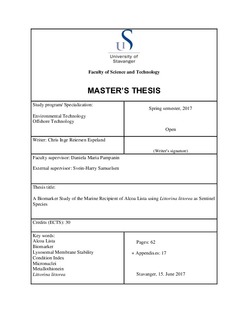| dc.contributor.advisor | Pampanin, Daniela Maria | |
| dc.contributor.author | Espeland, Chris Inge | |
| dc.coverage.spatial | Norway, Lista | nb_NO |
| dc.date.accessioned | 2017-10-04T10:33:35Z | |
| dc.date.available | 2017-10-04T10:33:35Z | |
| dc.date.issued | 2017-06-15 | |
| dc.identifier.uri | http://hdl.handle.net/11250/2458304 | |
| dc.description | Master's thesis in Environmental technology | nb_NO |
| dc.description.abstract | The waste water effluent from the Søderberg aluminium production plant Alcoa Lista is discharged into the marine recipient Husebybukta. The discharge contains several compounds that can have toxic effects on the living organisms. A biomonitoring study was performed using periwinkles (Littorina littorea) as bioindicators to assess the biological effects in the snails living in the vicinity of the production plant. The battery of biomarkers included lysosomal membrane stability (LMS), condition index (CI), micronuclei (MN), and metallothionein (MT). Morphological measurements were also taken. Snails were collected monthly from February to April 2017 from three sites in Lista: Haugestrand, Tjuvholmen, and Litlerauna. Snails were also collected from an additional reference station in Viste, Rogaland in the same sampling intervals.
The overall data from the battery of biomarkers selected for this study was capable of showing differences between sites, probably due to the differences in contaminant levels. Significantly lower LMS values were observed in snails from the two sites closest to the production plant (Haugestrand and Tjuvholmen), indicating that organisms are subjected to a general environmental stress, potentially due to the waste water discharge from Alcoa Lista. CI values were not significantly different in all organism collected at the area of Lista (both close to the production plant and in the reference location), indicating that the potential general stress registered at cellular level with the LMS assay is probably not causing physiological level effect in L. littorea Significantly higher MN frequencies were observed in snails collected in the vicinity of the production plant (Haugestrand and Tjuvholmen) compared to the reference sites, indicating that organisms close to the Alcoa Lista plant are subjected to a significant genotoxic stress possibly from toxic compounds discharge from the production plant. MT concentrations in tissues of snails collected at Lista were similar, indicating that the waste water discharge from Alcoa Lista does not contain pollutants capable of induction MT or their concentration is too low to induce MT, e.g. heavy metals. | nb_NO |
| dc.language.iso | eng | nb_NO |
| dc.publisher | University of Stavanger, Norway | nb_NO |
| dc.relation.ispartofseries | Masteroppgave/UIS-TN-IMN/2017; | |
| dc.rights | Navngivelse 4.0 Internasjonal | * |
| dc.rights | Navngivelse 4.0 Internasjonal | * |
| dc.rights.uri | http://creativecommons.org/licenses/by/4.0/deed.no | * |
| dc.subject | biomarker | nb_NO |
| dc.subject | lysosomal membrane stability | nb_NO |
| dc.subject | micronucleus | nb_NO |
| dc.subject | metallothionein | nb_NO |
| dc.subject | condition index | nb_NO |
| dc.subject | littorina littorea | nb_NO |
| dc.subject | teknisk miljøvern | nb_NO |
| dc.title | A Biomarker Study of the Marine Recipient of Alcoa Lista using Littorina littorea as Sentinel Species | nb_NO |
| dc.type | Master thesis | nb_NO |
| dc.description.version | submittedVersion | nb_NO |
| dc.subject.nsi | VDP::Technology: 500::Environmental engineering: 610 | nb_NO |

